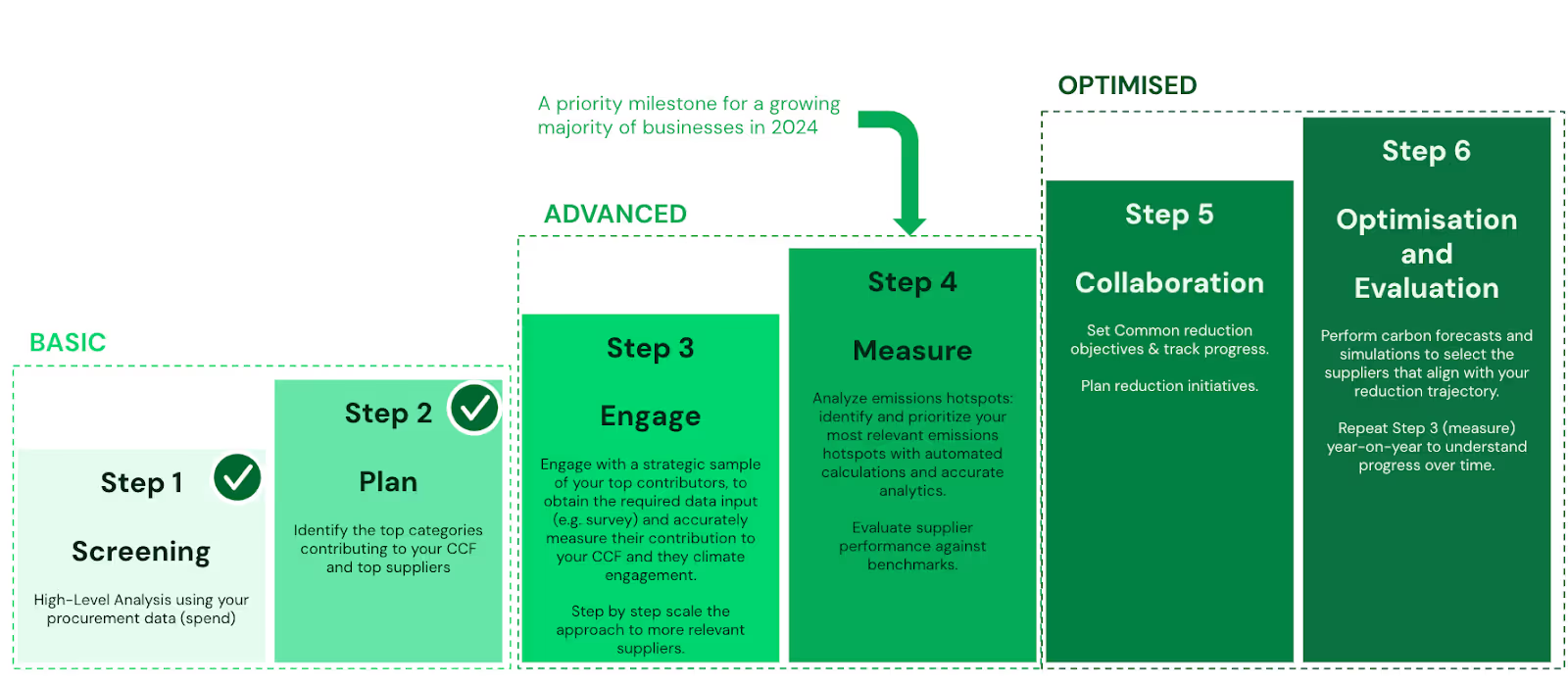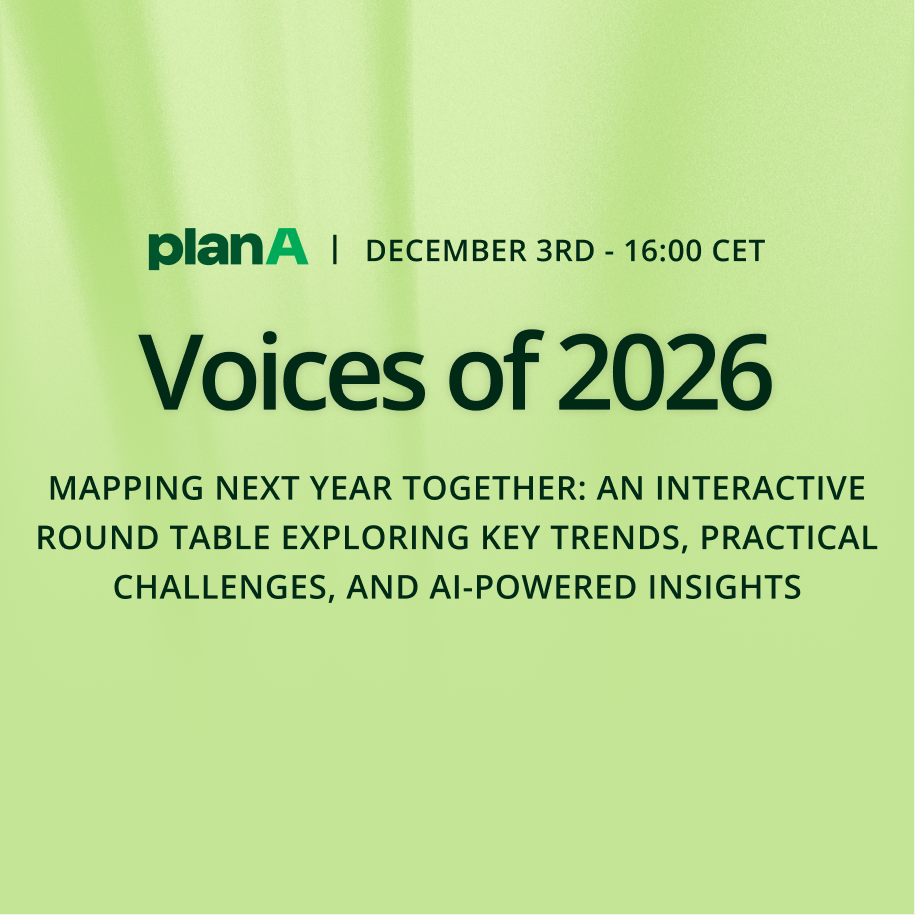Emissions generated in the value chain often constitute a significant portion of a company’s overall GHG emissions. By actively engaging with suppliers, companies can address these emissions beyond their direct control. Collaborative efforts reduce the risks associated with isolated endeavours and facilitate the sharing of best practices, technologies, and innovations to reduce emissions. This cooperation can lead to the development of new, more sustainable products and processes that neither party could achieve alone.
What is supplier engagement?
Every company that has embarked on the journey of GHG emissions calculation and decarbonisation will find it a huge challenge to estimate Scope 3-category 1 accurately and with sufficient granular and reliable data needed for decarbonisation and monitoring progress. Engaging suppliers helps companies gain visibility into where emissions are generated outside their direct operations and start gathering reliable data in a structured and scalable process. By working closely with suppliers, companies can encourage the adoption of standardised methods for data collection, ensuring the consistency and reliability of the emissions data reported.
Supplier engagement has other business benefits for companies
From a broader perspective, engaging suppliers may help to align their operations with the company's long-term sustainability goals, not only in GHG emissions but also in other environmental and social goals as required by the CSRD regulation and the ESRS standards. A formal engagement process encourages suppliers to measure, report, and disclose their emissions and other sustainability data. This transparency is essential for accurate reporting and tracking progress. Understanding suppliers' GHG emissions and other sustainability data helps identify potential risks related to non-compliance with sustainability regulations, reputational damage, and supply chain disruptions.
Proactive supplier engagement demonstrates a company’s commitment to sustainability, enhancing its reputation among consumers, investors, and other stakeholders. Transparent and responsible supply chain management contributes to stronger supplier relationships while improving credibility with stakeholders, including customers, employees, and investors.
Supplier engagement allows companies to:
- Collect reliable data from suppliers in an organised and replicable manner.
- Identify opportunities for emission reductions that may not be obvious without a comprehensive understanding of the entire supply chain (examples can include joint efforts to improve efficiency, switch to renewable energy sources, or redesign products for reduced environmental impact).
- Set coordinated efforts and targets between the reporting company and its suppliers to invest together, share and minimise risks, and report progress collectively without greenwashing or double-counting.
Collecting data and collaborating with suppliers for emission reduction have been consistently reported by companies as one of the main pain points in managing emissions in general and reducing Scope 3 emissions specifically. The challenges and barriers vary widely but are very much dependent on the complexity and length of a company's value chain, identification of the correct data and a process to collect this data in an operable and scalable manner, and finally, the ability of the reporting company to influence decisions of its suppliers.
Every company must create and adapt its internal processes to their requirements and resources. However, some best practices and tips can be used as guidance for starting the creation and implementation of a supplier engagement process. Based on Plan A's experience assisting our customers in managing Scope 3 emissions and a review of existing state-of-the-art literature, here we offer an overview of what a company can do to reach impactful decarbonisation along the supply chain.
How to get started with a supplier engagement
At this point, you should have finalised your corporate carbon footprint (CCF). Therefore, you already know the relative importance of your Scope 3 emissions within your whole CCF. In addition, your company has probably estimated the emissions in the value chain using spend data. This is the first recommended step and it is beneficial to screen the most relevant suppliers regarding spend and GHG emissions (see step 1 in Figure 1).

The second step consists of identifying the top supply categories (e.g., specific categories of physical products, services, cloud & IT, consultancy services, etc.) and top suppliers based on spend and their contribution to supply chain emissions. This identification will allow you to classify the supply categories and suppliers into hierarchies, which will be used in the following steps to prioritise the implementation of the supplier engagement programme, focusing on the more relevant suppliers and where there are more opportunities to reduce emissions.
Establish a supplier engagement programme
According to the GHG Protocol, there are two main phases that conform to a supplier engagement programme:
- Internal planning before engaging with suppliers
- Working with suppliers to collect data
Internal planning
It is good practice to establish the envisioned steps and processes internally with their corresponding relevant participants before engaging directly with suppliers to ensure that you have control over the process and that you can replicate and extend it for future iterations.
The following activities are suggested to be implemented as part of the necessary internal planning before actually engaging with suppliers:
- Identify the internal departments responsible for data collection. Before engaging with suppliers, you should identify if your company already has environmental or social responsibility initiatives that apply to their supply chain and see how to integrate these with a supplier engagement programme for managing carbon emissions (e.g., a supplier due diligence process that includes sustainability criteria). This can ensure consistency with your current practices and will help to reduce supplier burden (GHG Protocol).
- Identification of internal key departments and determination of responsibilities: Some departments within your company may be already responsible for collecting data directly or indirectly related to sustainability. Typical examples include Procurement, General Management, Environmental Affairs, or Social Responsibility. These departments are often responsible for supply chain management and can either coordinate the supplier engagement programme or be co-responsible parties in the collective effort.
Clear responsibilities must be established for data collection, data management, processing and quality assurance, GHG emissions calculation and monitoring reduction, and finally, reporting.
It is also good practice to set internal educational material and align it with the objectives, methods, and importance of the supplier engagement programme in case these departments are not familiar with sustainability and climate change. This may include providing training on how to communicate effectively with suppliers, handle common questions, and emphasise the executive support behind the programme.
- Select suppliers and identify supplier information: Depending on the data needs, complexity, and size of the supplier network, you should decide whether to select all suppliers (for a small supplier network) or a subset based on a prioritisation exercise (for large and complex supplier networks).
The criteria used to prioritise suppliers with whom to start the supplier engagement programme can be the following:
- Supplier screening is based on spending to select suppliers responsible for at least 80% of all GHG emissions in Scope 3 category 1 (as a general rule), as shown in Figure 1, step 1.
- Suppliers with the most significant potential for emission reduction and fewer potential challenges.
- Supplier's maturity in managing its sustainability and climate change-related data and processes (e.g., the supplier has a sustainability department, already reports GHG emissions, has reduction targets, etc.)
- Suppliers for which your company spend makes up a large proportion of revenue (meaning your company has potentially a greater possibility of influence).
- Potential changes in supplier relationships, such as additions, removals, or modifications to agreements might influence which suppliers should be included in the supplier engagement programme.
Suppliers categorised as highest-priority should be considered first to plan to engage with them more deeply.
The sustainability management maturity level of suppliers
Before collecting data from suppliers, it is a good practice to understand how mature your suppliers are in relation to their own GHG emissions management and classify them accordingly. This will allow establishing a differentiated approach to work together with them according to their capabilities and resources:
Low maturity level: These suppliers do not calculate, manage or report their emissions. Potentially not prioritised in the first iteration of the supplier engagement programme. You can engage these suppliers to help/train them on improving their GHG emissions management, collect additional activity data on relevant categories, etc.
Medium maturity level: These suppliers may have records of business activity data and/or GHG emissions. You can engage these suppliers and include them in the first iteration of your supplier engagement programme through questionnaires, surveys, and/or direct interviews to clearly identify what information and to what extent is useful for your supplier engagement programme objectives.
High maturity level: These suppliers already calculate and report their GHG emissions. They probably also have their own reduction targets. You should prioritise these suppliers in your first iteration of the supplier engagement programme, especially if they comply with your other defined prioritisation criteria.
- Develop a method for managing supplier data: According to the GHG Protocol, managing supplier data involves collecting data, ensuring its quality, and reporting outcomes. The selection of the correct data collection method and process is crucial for gathering suppliers' GHG data. The usage of specialised software can be the best way to improve the efficiency of handling supplier information, which will help alleviate the burden on suppliers, enhance transparency, and minimise potential errors and inconsistencies.
The following information should be gathered from suppliers:
- Description of emission sources and scope
- Boundary details
- Reporting period
- Activity data and GHG emissions
- Comparability with previous years' GHG calculation methodologies
- Details of emission factors and data sources
- Discussion of uncertainties
- Trends evident in data (if applicable)
- Already implemented reduction actions (if applicable)
- Progress towards targets (if applicable)
- Description of events affecting data (if applicable)
- Ratio indicators needed for allocation
- Any other relevant information
Managing supplier's data
Three activities are core when managing supplier's GHG-related data:
Data collection: you should clarify what type of data, through which means, and which specific units you need to collect. For the type of data, you should decide if you are interested only in GHG emissions, only in business activity data, or a combination of both. In relation to the means, it is crucial that you define what applies best to your company and your prioritised suppliers. This is if you will collect data through surveys, questionnaires, and interviews, but also to decide if you will collect data using manual or automatic processes (e.g., assisted by specialised software such as Plan A's).
Quality assurance: It is critical that you set up a step to ensure that the data you receive meets the required quality level. Examples can be ensuring that the data meets the specified units, time ranges, data outliers, typos, data gaps, etc.
Data analysis: The most critical part of the data analysis will be ensuring how changes in your supplier's emissions data will affect your company's scope 3 emissions. Plan A experts can provide dedicated assistance in this area.
Reporting: Finally, it is very important that you define how to report emissions from your suppliers and monitor their impact on your own CCF. Plan A software can help you accomplish this.
- Determine ways to proceed if suppliers choose not to provide data: As part of the supplier engagement programme, you should confront the possibility that some suppliers will decide not to share the required data. The SBTi recommends that the reporting company establish an approach to inducing a response from suppliers. This approach can take one of the following forms: 1) enforcing, 2) being supportive/ informative, or 3) inducing competition among suppliers. The selection of one form or the other should be based on the power of influence the company has over its suppliers. The possible solutions to this challenge need to be adapted to your particular circumstances and type of relationship with your suppliers. Some recommendations may be:some text
- To define contractual obligations with your suppliers to disclose data as part of your established due diligence process.
- To improve your communication and interaction with suppliers (through training, education, collaboration or any other form of support) that gives your suppliers more confidence and a feeling of shared responsibility.
- Creating competition between suppliers is especially applicable when you can select different suppliers for the same product or service, so you may choose other suppliers more willing to provide you with the required data or impose penalties on suppliers based on their commitment to your supplier engagement programme.
- Document your supplier engagement process: To enhance, replicate, and scale your supplier engagement efforts, it is crucial to meticulously document the processes and systems employed, along with all decisions and criteria established in earlier phases. This documentation is essential for refining and standardising your approach.
Working with suppliers to collect data
Now that you have planned and documented your supplier engagement programme, it is time to put it into action. GHG Protocol and other formal sources suggest some specific steps and activities to be carried out in this phase. In the following paragraphs, we will explain them.
- Launch the programme officially and announce it to your prioritised suppliers: This step will allow you to define and delimit the objectives, purposes, and expectations between you and your suppliers. It will create a common understanding and offer context on the what and the how of your supplier engagement programme. It is also critical that you identify the right person to address within the supplier companies and that you can define the correct point of contact for future interactions with them.
- Provide a training or information session on the data collection methodology: This session should be designed to familiarise the supplier’s point of contact with the data collection process and provide them with the information they need to undertake the data reporting. Organising this as a webinar or a dedicated workshop is a good practice so that all questions are clarified before you start collecting data. It is also important to remember that the supplier companies may need to collect data from different dispersed internal sources. Therefore, you must acknowledge this challenge and provide them with the tools, training, and assistance they need to overcome this issue.
- Check-in periodically with suppliers regarding their progress on collecting and reporting data: In this activity, your supplier's engagement programme manager should check with a predefined frequency what the supplier's progress is in achieving and sending the required data. It is also an opportunity to check if there are still unanswered questions or unclarities that the suppliers still might have. Using an automated reporting system simplifies this part of the process by enabling the tracking of supplier progress. This ongoing interaction ensures that the survey is completed promptly and fosters a collaborative partnership.
- Assess quality data and follow up: After receiving the required data, you must check that it complies with all the defined quality criteria. This may be, among other things, completeness and accuracy of qualitative and quantitative data, units, time ranges, data gaps, data outliers, missing information, information provided in non-compliant media, etc. After receiving and doing the quality check, it is good practice to communicate to your supplier that you have received the information and that there are no open issues in this regard.
Setting a collaboration approach for reducing emissions
During the first time of implementation of your supplier engagement programme, you will most probably be focused on selecting the right group of suppliers to be prioritised based on defined criteria (as described in the section about internal planning) to gain a deeper understanding of their carbon footprints and to gather data to improve your Scope 3 emissions calculation.
However, in the next iterations, it is recommended that supply chain emission reduction targets be set. You may use the GHG Protocol or SBTi guidance to set up reduction targets for purchased goods and services.
Since, at this point, you will have better data, it is possible to create reduction scenarios and projections, together with a deeper understanding of the emission sources in the supply chain that are responsible for emissions. These analyses will set up the foundation for identifying potential reduction initiatives. An additional goal of a well-established supplier engagement programme is that you can implement the identified initiatives in close collaboration with your suppliers.
It is also important to remember that not all suppliers are at the same maturity level and, therefore, cannot adopt reduction initiatives immediately. For some suppliers, initiatives will need to start with improving their understanding of climate change issues, data collection and emissions calculations; medium-mature suppliers will potentially need some training and close collaboration to implement and monitor reduction actions, while very mature suppliers will likely have their own reduction targets and actions, making it more essential to create synergies and standard processes to build on their existing efforts.
You can find additional resources on supplier engagement that were also used for the creation of this article in the following links:
- https://ghgprotocol.org/sites/default/files/2022-12/Supplier%20Engagement%20Guidance.pdf
- https://sciencebasedtargets.org/resources/files/Supplier-Engagement-Guidance.pdf



.jpg)

.avif)



